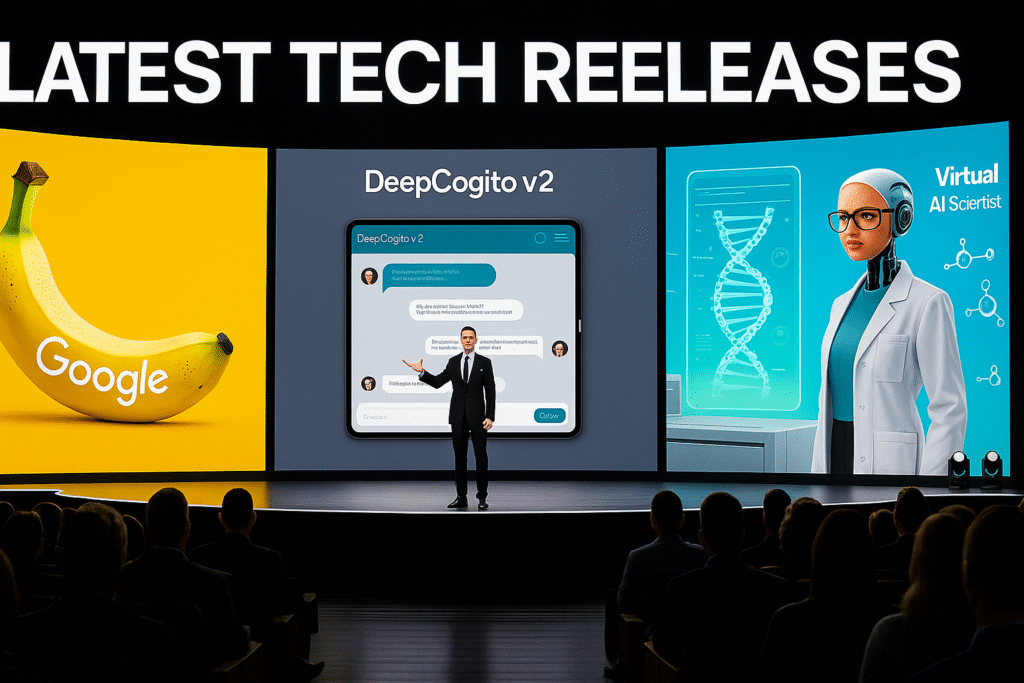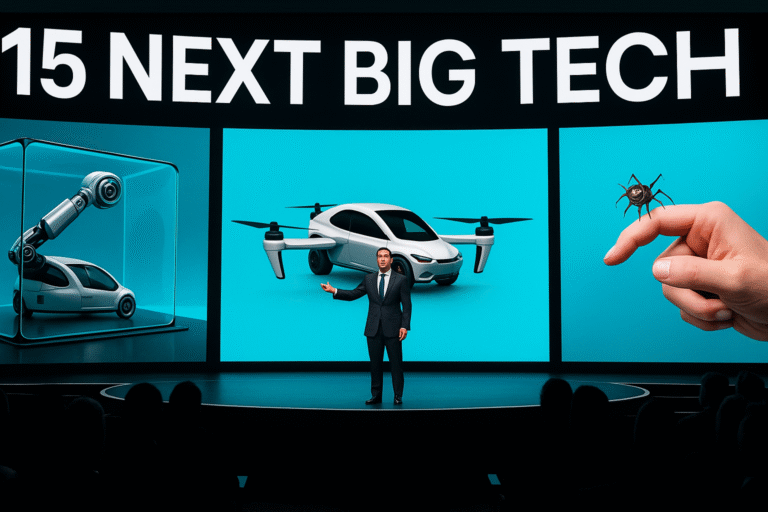
Introduction – Why August 2025 Was a Game-Changer {#introduction}
August 2025 wasn’t just another month in tech—it was a historic wave of breakthroughs. From AI-powered drug discovery and autonomous helicopters to billion-dollar infrastructure deals, these innovations didn’t just make headlines, they reshaped industries.
This list of the August 2025: Top 15 Tech Innovations captures the biggest releases, deals, and discoveries that are already influencing healthcare, transportation, entertainment, and AI research worldwide.
15. Google Gemini 2.5 Flash Image (Nano Banana) {#google-gemini}
On August 26, 2025, Google launched Gemini 2.5 Flash Image, nicknamed Nano Banana.
- Strengths: Ultra-fast AI image generation (up to 6x faster than ChatGPT’s image tool).
- Unique Feature: Maintains character consistency across multiple images.
- Safety Layer: Every image stamped with SynthID watermark to identify AI outputs.
Concerns: The Washington Post warned about misinformation risks as AI-generated images get harder to detect.
14. OpenAI GPT-5 Launch {#openai-gpt5}
Released on August 7, 2025, GPT-5 brought:
- Dynamic Routing → balances fast vs. detailed responses.
- Multimodal AI → text, images, and voice in one system.
- 40% Performance Boost → especially in coding & logic (Financial Times).
Challenges: Users complained about glitches, weekly caps, and reduced creativity compared to GPT-4o. OpenAI had to restore legacy models temporarily.
13. DeepMind Genie 3 {#deepmind-genie3}
Unveiled on August 5, 2025, Genie 3 generates interactive environments from text prompts.
- Example: Type “city street at night” → explore it in real-time at 24 FPS.
- Applications: Education, training, and creative prototyping.
This is a leap toward accessible simulations, reducing reliance on heavy game engines.
12. Stanford’s Virtual AI Scientists {#stanford-ai}
In early August, Stanford introduced multi-agent AI scientists for drug discovery.
- Results: Generated 92 novel COVID-19 treatments in days, with 2 strong candidates.
- How It Works: Agents autonomously hypothesize, simulate, and refine results.
Impact: Could cut research timelines from years to weeks, though ethical concerns remain about AI autonomy in medicine.
11. Paramount’s $7.7B UFC Streaming Deal {#paramount-ufc}
On August 11, 2025, Paramount secured a 7-year, $7.7 billion contract for exclusive UFC streaming rights.
- All numbered events → stream on Paramount+.
- Select fights → simulcast on CBS.
Industry Impact: Ends UFC’s reliance on pay-per-view, aligning it with NFL-style streaming deals.
10. Ford’s $2B EV Pickup Retooling {#ford-ev}
Ford announced a $2 billion investment in its Louisville plant to produce a $30,000 midsize EV pickup by 2027.
- Jobs Created: ~2,200 in Kentucky.
- Manufacturing: Uses a new 3-branch assembly tree system for efficiency.
This move directly challenges China’s affordable EV sector, positioning Ford for global competition.
9. Texas AI-Powered Helicopters {#texas-helicopters}
Texas A&M, with DARPA funding, began converting UH-60 Blackhawks into AI-piloted helicopters.
- Purpose: Wildfire response, surveillance, supply delivery.
- Budget: $59.8 million project.
Tests will run across Texas, aiming to reduce firefighter risks in severe wildfire seasons.
8. Revel’s EV Charging Pivot {#revel-ev}
On August 11, 2025, Revel announced it would shut down ride-hailing to focus on EV charging hubs.
- Already active in NYC & San Francisco.
- Plans for dozens more hubs in U.S. cities.
With EV adoption rising but charging still lagging, Revel is betting its future on infrastructure, not ridesharing.
7. South Korea’s 8% AI Funding Boost {#south-korea-ai}
In mid-August, South Korea approved an 8% budget increase for AI research—its largest in 4 years.
- Focus: Domestic chipmakers + AI startups.
- Goal: Compete with U.S. and China in generative AI.
This move shows South Korea’s intent to secure a stronger AI foothold globally.
6. Microsoft Windows 11 AI Update {#microsoft-windows11}
In August 2025, Microsoft rolled out a major Windows 11 update powered by Copilot AI tools.
- Features: Users can now perform system recovery, manage settings, and troubleshoot using natural language.
- Smart Assistance: Copilot suggests fixes and shortcuts based on real-time activity.
While smaller than model launches, this marks a huge shift in everyday computing, embedding generative AI at the OS level for millions of users.
5. Google’s $9 Billion AI Data Centers in Oklahoma {#google-data-centers}
Google confirmed a $9 billion investment in AI-optimized data centers across Oklahoma.
- Purpose: Train large AI models at scale.
- Jobs: Thousands of construction and long-term roles expected.
- Green Tech: Facilities powered by renewable energy.
According to Crescendo AI, this is one of Google’s largest single-state tech builds, underscoring the infrastructure arms race in AI.
4. Reliance Intelligence Launch in India {#reliance-intelligence}
On August 29, 2025, Mukesh Ambani announced Reliance Intelligence, a new AI subsidiary.
- Partners: Backed by Google & Meta collaborations.
- Focus: Healthcare, education, and finance AI applications.
- Goal: Position India as a global AI leader within a decade.
The Economic Times described it as one of the biggest corporate-led AI pushes in Asia, signaling that AI competition is no longer just U.S. vs China.
3. OpenAI & Broadcom Chip Deal {#openai-broadcom}
In late August, OpenAI struck a hardware deal with Broadcom to mass-produce its custom AI chips starting in 2026.
- Why It Matters: Reduces reliance on NVIDIA GPUs, which dominate AI training.
- Shift: OpenAI moves from software-first to full-stack AI development.
Analysts call it one of 2025’s biggest AI hardware plays, reshaping competition in the chip industry.
2. Meta & Google’s $10 Billion Cloud Partnership {#meta-google}
Toward the end of August, Meta and Google shocked the industry by announcing a $10 billion cloud infrastructure partnership.
- Collaboration: Meta will use Google Cloud for AI workloads.
- Why It Matters: These rivals are pooling resources to cut costs of massive AI model training.
Experts view this as proof that AI infrastructure is so costly, even tech giants must collaborate instead of competing alone.
1. DeepCog Version 2 Release {#deepcog}
Between July 31 and August 1, DeepCog released Version 2, a suite of open-source hybrid reasoning models.
- Scale: 70B to 671B parameters.
- Efficiency: Designed to use intuition-based shortcuts, reducing inference steps.
- Results: Strong performance on logic benchmarks at lower costs.
Unlike closed systems like GPT-5, DeepCog’s open-source release empowers researchers worldwide. Many see it as a democratizing move for advanced reasoning AI.
FAQs on August 2025 Tech Innovations {#faqs}
1. What was the biggest AI breakthrough in August 2025?
DeepCog Version 2 stood out for releasing open-source reasoning models, empowering global researchers.
2. How did OpenAI improve with GPT-5?
GPT-5 introduced dynamic routing and multimodal processing, making it smarter in coding and logic tasks.
3. Which deal reshaped entertainment?
Paramount’s $7.7 billion UFC streaming deal ended decades of pay-per-view dominance.
4. What major EV news happened in August 2025?
Ford announced a $2B investment in an affordable midsize EV pickup, starting at $30,000.
5. How is South Korea competing in AI?
The government boosted its AI funding by 8%, targeting chipmakers and startups to compete with the U.S. and China.
6. Why is the Meta-Google deal important?
It reflects the high costs of AI infrastructure, showing even rivals must collaborate to scale.
Conclusion – The Ripple Effect of August 2025 {#conclusion}
The August 2025: Top 15 Tech Innovations prove one thing—technology is accelerating faster than ever.
From AI breakthroughs in medicine, simulation, and reasoning to massive corporate investments in EVs, cloud, and data centers, the month reshaped industries worldwide.
As AI becomes more powerful, affordable EVs enter the market, and sports move to streaming, these changes signal a new era of innovation. What seemed futuristic just a few years ago is now today’s reality—and the ripple effects will define the next decade.


